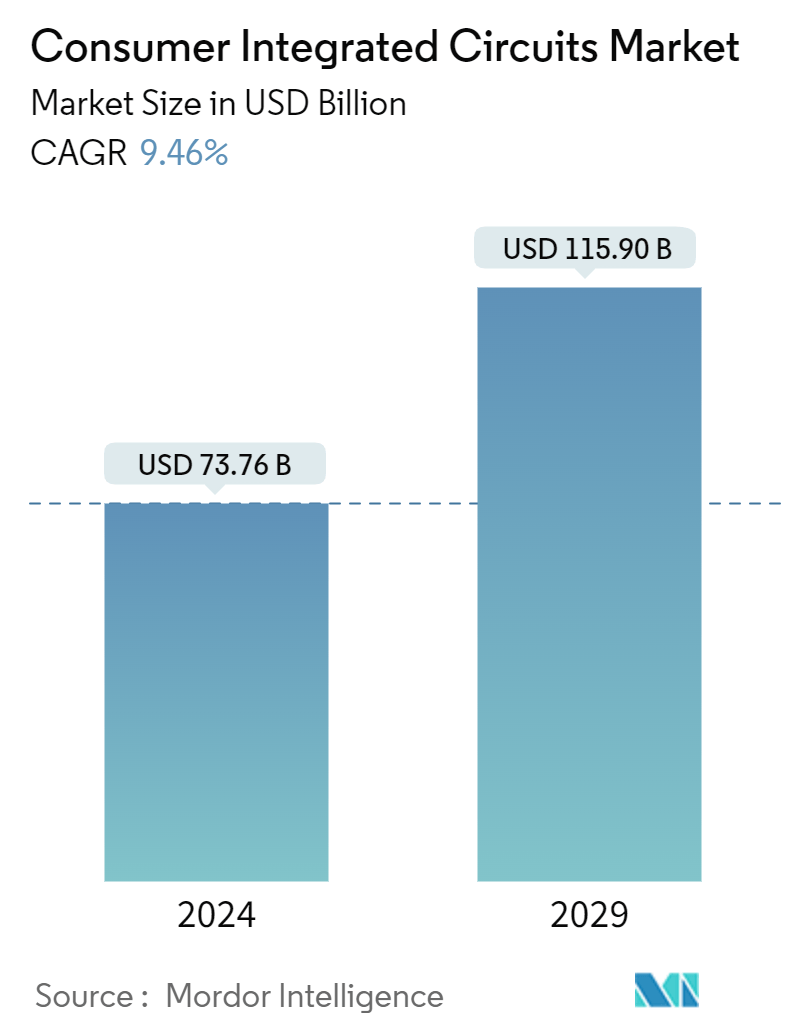Market Size of Consumer Integrated Circuits Industry

| Study Period | 2019 - 2029 |
| Market Size (2024) | USD 73.76 Billion |
| Market Size (2029) | USD 115.90 Billion |
| CAGR (2024 - 2029) | 9.46 % |
| Fastest Growing Market | Asia Pacific |
| Largest Market | Asia Pacific |
Major Players
*Disclaimer: Major Players sorted in no particular order |
Consumer Integrated Circuits Market Analysis
The Consumer Integrated Circuits Market size is estimated at USD 73.76 billion in 2024, and is expected to reach USD 115.90 billion by 2029, growing at a CAGR of 9.46% during the forecast period (2024-2029).
- Consumer electronics devices such as smartphones, televisions, gaming consoles, and smart home devices rely on digital processing. The ICs, specifically digital logic ICs, are designed to process and manipulate digital signals and perform logical operations. They are essential for data storage, arithmetic calculations, control functions, and signal routing. Due to the surging adoption of consumer electronic devices, the demand for logic ICs is projected to grow.
- Further, the IoT market continues to grow, connecting various consumer electronic devices to enable seamless communication. The ICs are crucial in IoT devices as they handle data processing, sensor integration, connectivity, and control functions. As the IoT market expands, ICs capable of low-power and wireless communication will be increasingly sought after.
- In addition, the increasing use of IoT in the consumer electronics industry propels the excess adoption of AI, with applications such as virtual assistants, voice recognition, image processing, and machine learning. Logic integrated cicruits (ICs), particularly specialized AI accelerators, and neural network processors are likely to be in high demand to support the computational requirements of AI algorithms in consumer electronic devices.
- The design of modern IC (integrated circuit) technology poses several challenges. Advanced technology nodes in the manufacturing process exhibit notable variability. Variability in the operation of numerous devices on advanced ICs leads to fluctuations in operating voltage, temperature, and performance. To maintain essential qualities such as fidelity, consistency, and performance, IC design must address these effects. Complex designs may be susceptible to manufacturing variations, yield issues, and other challenges, thereby impeding market growth.
- Macroeconomic factors like Inflation have a significant impact on manufacturing. They cause higher manufacturing costs due to increased prices for raw materials, shipping costs, labor costs, and shortages. This often leads manufacturers to raise prices to sustain profitability, resulting in decreased product demand. Additionally, Inflation may result in contract limitations, changes in labor, and input challenges for manufacturers. The escalation of Inflation could impede the growth of the market being studied.

